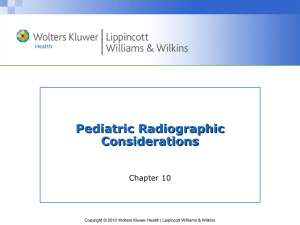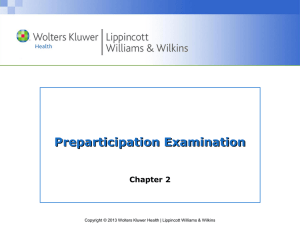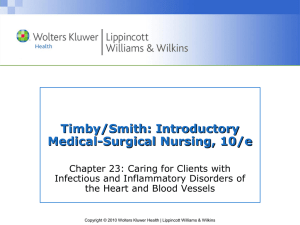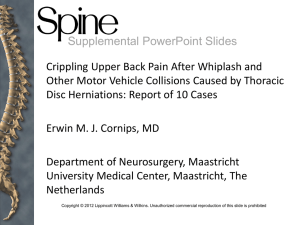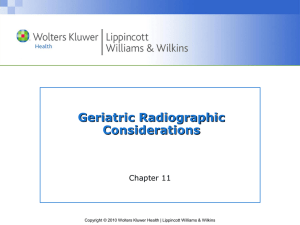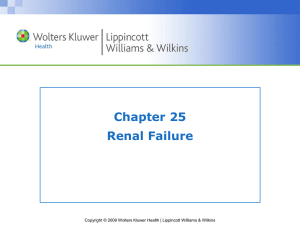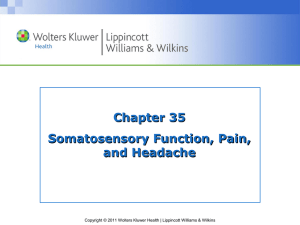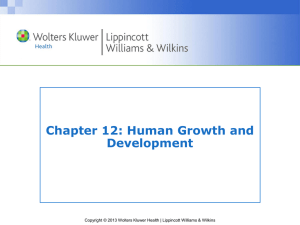again
advertisement
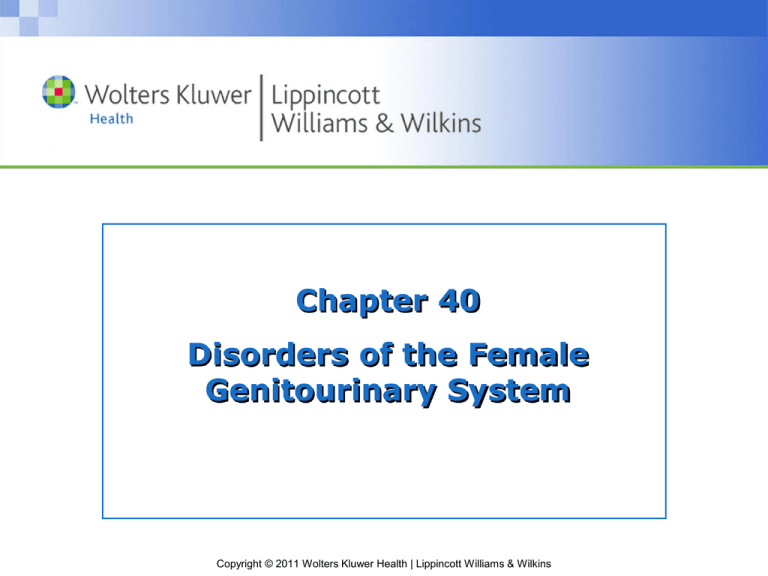
Chapter 40 Disorders of the Female Genitourinary System Copyright © 2011 Wolters Kluwer Health | Lippincott Williams & Wilkins Female Reproductive Anatomy Copyright © 2011 Wolters Kluwer Health | Lippincott Williams & Wilkins Estrogens • Sexual maturation • Ovulation • Development and maintenance of female accessory organs • Cell division in breasts and endometrium • Maintaining skin and blood vessels • Decreasing bone resorption • Increased HDL levels, decreased LDL, and cholesterol • Moving fluid into tissues Copyright © 2011 Wolters Kluwer Health | Lippincott Williams & Wilkins Progesterones • Maintaining pregnancy • Breast and endometrium development • Maturation of endometrium cells • Increased body temperature • Smooth muscle relaxation Copyright © 2011 Wolters Kluwer Health | Lippincott Williams & Wilkins The Menstrual Cycle • Gonadotropin-releasing hormone (GnRH) from the hypothalamus begins the cycle Hypothalamus GnRH • It causes the anterior pituitary to release follicle-stimulating hormone (FSH) and luteinizing hormone (LH) Anterior pituitary FSH Copyright © 2011 Wolters Kluwer Health | Lippincott Williams & Wilkins LH The Menstrual Cycle (cont.) • Follicle-stimulating hormone (FSH) and luteinizing hormone (LH) make ovarian follicles begin to mature • This is the follicular phase of the menstrual cycle anterior pituitary FSH LH ovarian follicles begin to mature Copyright © 2011 Wolters Kluwer Health | Lippincott Williams & Wilkins The Menstrual Cycle (cont.) • The developing follicle produces estrogen anterior pituitary negative feedback inhibits FSH release FSH LH ovarian follicles begin to mature • Estrogen decreases FSH release • Only the strongest follicles survive the drop in FSH estrogen Copyright © 2011 Wolters Kluwer Health | Lippincott Williams & Wilkins The Menstrual Cycle (cont.) strongest follicle survives continued estrogen production stimulates LH release • Only the strongest follicles survive the drop in FSH • Follicles continue to make estrogen • Estrogen now stimulates LH release from the anterior pituitary Copyright © 2011 Wolters Kluwer Health | Lippincott Williams & Wilkins The Menstrual Cycle (cont.) LH surge follicle bursts open OVULATION oocyte released into fallopian tube remaining follicle cells become corpus luteum progesterone • LH surge causes release of the egg • Ovulation • Follicle cells become corpus luteum, making progesterone • This is called the luteal phase of the cycle Copyright © 2011 Wolters Kluwer Health | Lippincott Williams & Wilkins The Menstrual Cycle (cont.) LH surge • Progesterone prepares the body for pregnancy follicle bursts open OVULATION • If pregnancy does not occur, the corpus luteum dies oocyte released into fallopian tube remaining follicle cells become corpus luteum progesterone • The drop in progesterone tells the hypothalamus to secrete GnRH and begin a new cycle Copyright © 2011 Wolters Kluwer Health | Lippincott Williams & Wilkins Question Which hormone slows down the release of FSH? a. LH b. Estrogen c. Progesterone d. GnRH Copyright © 2011 Wolters Kluwer Health | Lippincott Williams & Wilkins Answer b. Estrogen Estrogen, produced by the developing follicle, decreased FSH release (which only the strongest follicles will be able to survive). The remaining follicles continue to produce estrogen, which will stimulate the pituitary gland to release LH. Copyright © 2011 Wolters Kluwer Health | Lippincott Williams & Wilkins Disorders of the External Genitalia • Bartholin gland cyst and abscess • Leukoplakia – Lichen sclerosus – Lichen simplex chronicus • Vulvodynia – Cyclic vulvodynia – Vulvar dermatoses – Vulvar dysesthesia Copyright © 2011 Wolters Kluwer Health | Lippincott Williams & Wilkins Vulvar Carcinomas • In younger women: – Often preceded by vulvar intraepithelial neoplasia – Related to human papillomavirus infection • In older women – Often preceded by non-neoplastic disorders – Lesions cause itching and repeated injury – Healing cells are more likely to mutate Copyright © 2011 Wolters Kluwer Health | Lippincott Williams & Wilkins Vaginal Bacterial Flora • Many different species of bacteria – Dominated by species that produce lactic acid – Vaginal pH 3.8–4.2 – Protect against infections • Normal flora can be disrupted by: – Abnormal estrogen levels – Increased glycogen availability – Antibiotics Copyright © 2011 Wolters Kluwer Health | Lippincott Williams & Wilkins Cervical Epithelium • Inside the cervix: columnar epithelium • Exposed to acid in vagina: transforms to squamous epithelium • Transforming cells are more likely to become cancerous Copyright © 2011 Wolters Kluwer Health | Lippincott Williams & Wilkins Cancers of the Cervix and Vagina • Cervical cancer – Related to human papillomavirus infection • Vaginal cancer – Related to prenatal exposure to diethylstilbestrol – May also be caused by: º Spread of cervical cancer º Human papillomavirus infection º Chronic local irritation Copyright © 2011 Wolters Kluwer Health | Lippincott Williams & Wilkins Question Tell whether the following statement is true or false: HPV is a contributing factor to both vulvular and cervical cancer. Copyright © 2011 Wolters Kluwer Health | Lippincott Williams & Wilkins Answer True In young women, HPV has been linked to vulvular cancer; it also causes 70% of cervical cancers. Copyright © 2011 Wolters Kluwer Health | Lippincott Williams & Wilkins Anatomic Abnormalities • Disorders of pelvic support – Cystocele – Rectocele – Uterine prolapse • Variations of uterine position Copyright © 2011 Wolters Kluwer Health | Lippincott Williams & Wilkins Endometrial Disorders • Endometritis • Pelvic inflammatory disease • Endometriosis • Adenomyositis • Endometrial cancer • Leiomyomas Copyright © 2011 Wolters Kluwer Health | Lippincott Williams & Wilkins Pelvic Inflammatory Disease • Infection ascends through uterus to fallopian tubes and ovary • Inflammation causes: – Pain in lower abdomen and cervix – Purulent discharge – Increased WBC count – Increased C-reactive protein Copyright © 2011 Wolters Kluwer Health | Lippincott Williams & Wilkins Endometriosis • How did the tissue get there? – Up through the fallopian tubes (retrograde menstruation) – Activation of dormant cells that were always there • The ectopic implants respond to hormones – Go through menstrual cycle – During menstrual period, tissue dies and bleeds – Pain and adhesions result Copyright © 2011 Wolters Kluwer Health | Lippincott Williams & Wilkins Endometrial Cancer • Endometrial cancer has sometimes been caused by administration of estrogen without progesterone Question • Why would this make cancer more likely? Copyright © 2011 Wolters Kluwer Health | Lippincott Williams & Wilkins Ovarian Disorders • Ovarian cysts • Polycystic ovary syndrome • Benign ovarian tumors • Functioning ovarian tumors – Estrogen secreting – Androgen secreting – Mixed estrogen and androgen secreting • Ovarian cancer Copyright © 2011 Wolters Kluwer Health | Lippincott Williams & Wilkins Polycystic Ovary Syndrome • Follicles develop • But they do not ovulate after the LH surge • The high LH levels continue • LH stimulates androgen production • This interferes with ovulation even more • Ovaries contain many unovulated follicles ovarian follicles begin to mature strongest follicle survives decreased FSH levels continued estrogen production stimulates LH release LH surge follicle bursts open OVULATION Copyright © 2011 Wolters Kluwer Health | Lippincott Williams & Wilkins Benign and Functioning Ovarian Tumors • Benign tumors – Epithelial cell: cystadenomas – Endometriomas or “chocolate cysts” – Fibromas – Cystic teratomas or dermoid cysts: develop from germ cells • Functioning tumors: secrete hormones – Estrogens: alter menstrual cycle – Androgens: cause masculine characteristics Copyright © 2011 Wolters Kluwer Health | Lippincott Williams & Wilkins Ovarian Cancer • Associated with family history of ovarian and breast cancer • Causes vague GI symptoms • Up to 75% of cases have metastasized by the time they are discovered • No good screening tests available Copyright © 2011 Wolters Kluwer Health | Lippincott Williams & Wilkins Question Tell whether the following statement is true or false: Early detection through screening tests has improved the prognosis of ovarian cancer. Copyright © 2011 Wolters Kluwer Health | Lippincott Williams & Wilkins Answer False Because the signs and symptoms of ovarian cancer are so vague, the majority of patients do not seek medical attention until the disease is advanced (the cancer has usually metastasized by then). There are currently no good screening tests available to detect ovarian cancer. Copyright © 2011 Wolters Kluwer Health | Lippincott Williams & Wilkins Menstrual Disorders • Dysfunctional menstrual cycles • Dysfunctional bleeding • Amenorrhea • Dysmenorrhea • Premenstrual syndrome • Menopause and aging changes Copyright © 2011 Wolters Kluwer Health | Lippincott Williams & Wilkins Scenario • Ms. T is 63 and postmenopausal. She used hormone replacement therapy for 8 years after her menopause, but discontinued it on her doctor's advice 4 years ago • She has come into the clinic to request birth control • She says she has started to menstruate again and her breasts have “plumped out” Question • What do you think is happening? Copyright © 2011 Wolters Kluwer Health | Lippincott Williams & Wilkins Menopause or Climacteric • Decreased ovary function anterior pituitary negative feedback inhibits FSH release FSH • Low estrogen LH – Osteoporosis risk – Atherosclerosis risk ovarian follicles begin to mature estrogen • Less inhibition of pituitary – Increased FSH and LH – Hot flashes Copyright © 2011 Wolters Kluwer Health | Lippincott Williams & Wilkins Question Why are post-menopausal women at risk for osteoporosis? a. Diminished function of the ovaries b. Decreased progesterone levels c. Decreased estrogen levels d. Increased levels of FSH and LH Copyright © 2011 Wolters Kluwer Health | Lippincott Williams & Wilkins Answer c. Decreased estrogen levels Estrogen stimulates osteoblasts (bone cells that build/synthesize bone tissue). Lower levels of estrogen = less stimulation of osteoblasts = decreased bone density = increased risk of osteoporosis (decreased bone density, especially spongy bone). Copyright © 2011 Wolters Kluwer Health | Lippincott Williams & Wilkins Breast Anatomy Copyright © 2011 Wolters Kluwer Health | Lippincott Williams & Wilkins Disorders of the Breast • Mastitis • Ductal ectasia • Fibrocystic changes • Breast cancer Copyright © 2011 Wolters Kluwer Health | Lippincott Williams & Wilkins Breast Cancer • Cancer develops when cells mutate and are not repaired – BRCA1 and BRCA2 genes code for proteins that help repair DNA after it has mutated – Mutation of BRCA1 or BRCA2 make cancer more likely • In a cancer, cells continue dividing too fast – Estrogen and other growth factors make breast cells divide – Breast cells with too many estrogen or growth factor receptors are more likely to become cancerous Copyright © 2011 Wolters Kluwer Health | Lippincott Williams & Wilkins
